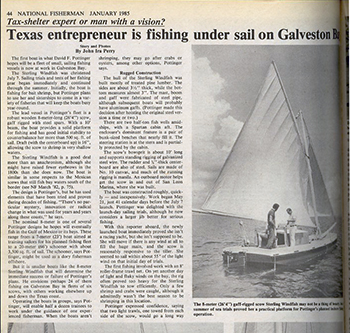In 1984, Texas entrepreneur David Pottinger had a plan to build a fleet of small sailing boats that would work the fisheries in Galveston Bay. When the first of the fleet, the 26' 4" Sterling Windfish, launched, National Fisherman writer John Ira Perry came along for an assessment:
"The boat was constructed roughly, quickly — and inexpensively. Work began May 21, just 41 calendar days before the July 7 launch. Pottinger was delighted with the launch-day sailing trials, although he now considers a larger jib better for serious fishing.
"With this reporter aboard, the newly launched boat immediately proved she isn't a racing yacht, but she isn't supposed to be. She will move if there is any wind at all to fill the huge main, and the scow is reasonably responsive to the tiller."
However, her main problem was fishing.
"The first fishing involved work with an 8' roller-frame trawl net. On yet another day of light and fluky winds on the bay, the rig often proved too heavy for the Sterling Windfish to tow efficiently. Only a few shrimps and crabs were caught, although it admittedly wasn't the best season to be shrimping in this location."
Pottinger wasn't discouraged. He quickly made the decision to switch from one shrimp trawl to two smaller ones on each side of the boat to give the boat better maneuverability.
I don't know if he came anywhere close to realizing his dream of a fleet of two dozen sailboats fishing the Gulf of Mexico. It may just have been a dream, but his efforts were among the first in the shift to more energy efficient fishing that has increased recently as high fuel prices cut deep into fishermen's profits.
The price of fuel has long been a game-changer. When it was cheap, fishermen were quick to switch from sails to motor-powered boats and adopted fishing methods that used those engines to target fish as efficiently as possible.
 Now that fuel's expensive, fishermen are naturally investing in technology that burns less of it. For some, that means taking another look at sail power. In my story, "Second wind," which begins on page 20 of our September issue, you'll meet a couple fishermen who are fishing from sail-assisted vessels.
Now that fuel's expensive, fishermen are naturally investing in technology that burns less of it. For some, that means taking another look at sail power. In my story, "Second wind," which begins on page 20 of our September issue, you'll meet a couple fishermen who are fishing from sail-assisted vessels.
Unlike the Sterling Windfish, these aren't constructed roughly. They're thoughtfully designed boats that use sail power as an alternative source of energy. Dan Patterson, in particular, is a commercial fisherman and avid sailor. In addition to the sail on his boat, he's incorporating little things he's learned on sail craft that add up to savings on the water. It makes sense. Every cent saved is money added back to his and his crew's paychecks.
For centuries, fishermen's main concern was finding the fish and hauling it in as quickly as possible. Now that fishermen are concerned about energy efficiency, it will be interesting to see how they'll burn less fuel while remaining profitable on the water. National Fisherman will continue to share their stories.
I hope you enjoy the article, and if anyone knows what happened to the Sterling Windfish and Pottinger's fleet dreams, please drop me a line at [email protected]. If I hear anything, I'll let you know.







